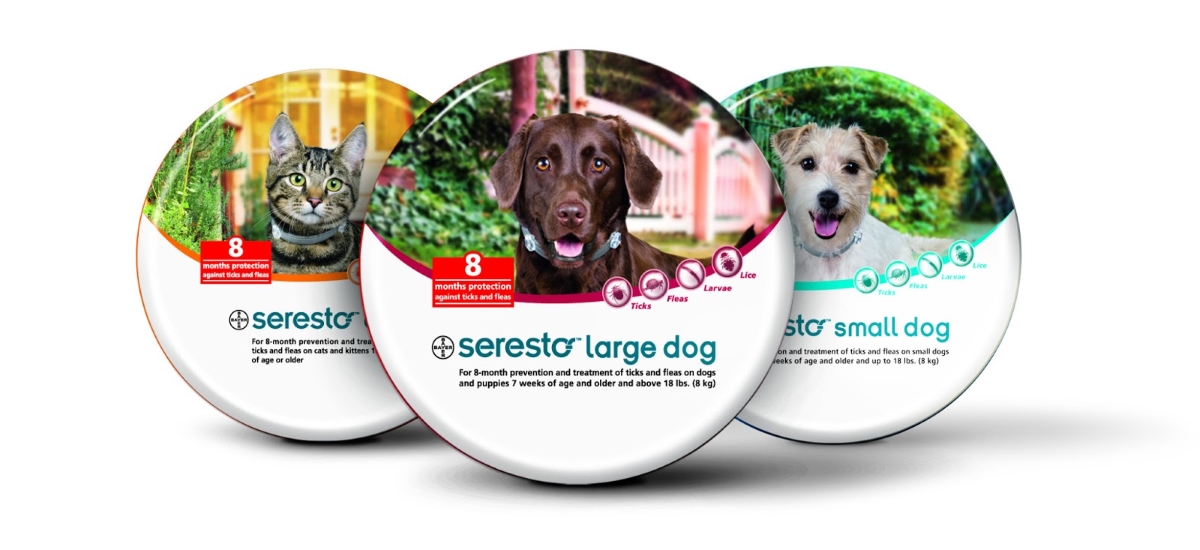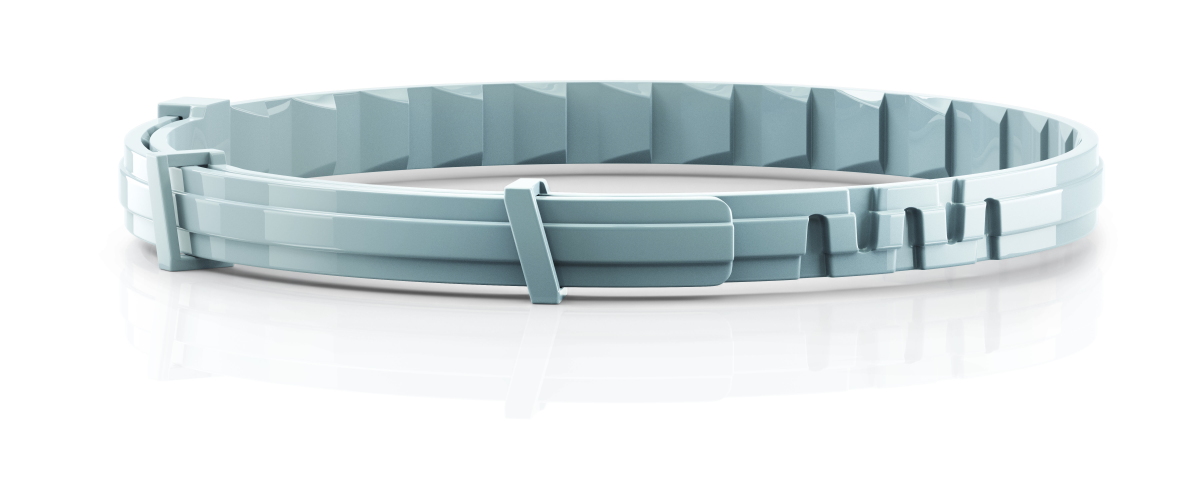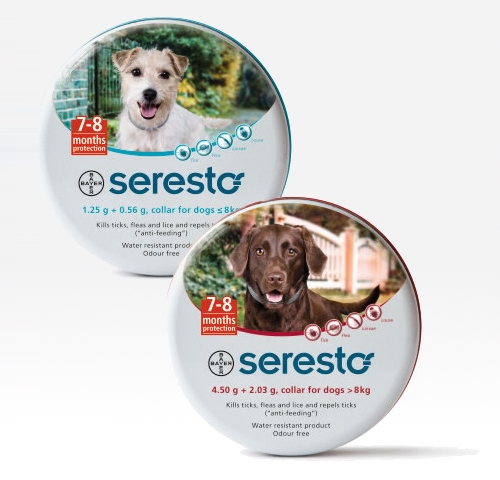Many people are surprised to learn that flea collars are still around, but if you and your dog are battling fleas, a flea collar could be the solution.
Flea collars have been in use much longer than most people realize. They were invented by Robert Goulding, Jr. way back in 1964. He was working on research using insecticides and animals when he came up with the idea for a collar that would be impregnated by chemicals that would slowly be released.
Since then, other solutions such as sprays, topical spot treatments and pills have come into use but flea collars do offer several advantages, and disadvantages, as we will discuss later.
What Is The Best Flea Collar?
Since most people reading this article will simply want to find out which is the best dog flea collar, so we cover that first...and the winner is Bayer Seresto Dog Flea Collar
Bayer Seresto
Flea Collar

Waterproof
Lasts For Up To 8 Months
Kills and Repels Pests - can be used both to treat infestations and as a preventative measure
Amber Crown
Baltic Amber Flea Collar

Natural Pest Repellent
Great for dogs that are allergic to chemical treatments
Safe for puppies and pregnant or nursing dogs
Full Bayer Seresto Flea and Tick Collar Review

We are not aware of any other flea collar that is as well thought our, durable and effective as Bayer's Seresto Collar, so we give it our recommendation.
You can get the Seresto collar in two sizes, one for larger dogs and one for smaller dogs. Make sure you get the correct size.
The collar is odour free and non-greasy, although when you open the packaging you may notice a white powder residue on the surface of the collar. This is stearic acid, a substance graded for food use, which helps release the collar during the moulding process and is totally harmless.
Once on your pet you will be glad to know it also features two safety release mechanisms. This ensures that if your dog gets the collar caught, it will allow them to escape unharmed, perfect for those dogs that like to rummage through the undergrowth.

Active Ingredients
To effectively control the parasites, the Seresto collar uses a combination of well known anti-parasite chemicals Imidacloprid (10%) and Flumethrin (4.5%). The collar is a cleverly constructed polymer latticework that consistently releases the correct dose for as much as 8 months. This collar is only recommended for dogs over 7 weeks of age and not for those that are pregnant or nursing.
We would suggest that if you are only looking to use it as a preventative measure only put it on your pets when they are going outside. While the chemicals have been shown to be safe, you don't want to put them on your dog unless you have to. It should be noted that while it is water-resistant if the collar is submerged frequently this effective period will drop.
If your dog shows any adverse reactions whether on their skin or lethargy or lose their appetite, stop using the collar and take your dog to see the vet.
If your dog is active and spends time in parks or woodlands the Bayer Seresto is the quite simply best flea collar for dogs. It provides a very cost-effective, low maintenance treatment if your dog is already infested and also acts as an excellent repellent if your dog does not have fleas.
However if your dog spends most of their time indoors or low risk areas, the Celesto collar is probably overkill. Also if your dog shows any adverse reactions, you may find our alternative collar a better solution.
Amber Crown Baltic Amber Flea Collar Review
If your pet is pregnant, nursing or young, or you or your pet is allergic to pesticides then buying one of these Baltic Amber Flea Collar could be a smart move. While less effective on an existing infestation, it is a very effective repellent and uses no harsh chemicals.
Amber is natural tree resin fossilized in millions of years and works to repel pests in two ways. When worn on the collar the pieces of amber rub together and release aromatic terpines that repels ticks and fleas.
In addition the effect of the amber rubbing on the dog's fur builds up static electricity in the same way as when you rub balloons on your hair or clothing and can stick them to the ceiling. This static charge makes parasites uncomfortable and unable to cling to your pet's fur, further discouraging them.
Only unpolished amber works as once the surface becomes polished they do not have the rough edges to release the terpines or generate any static charge. Typically this collar will be effective for about 3 months.
How Does a Flea Collar Work?
There are two types of flea collars - those that emit a gas and those that release chemicals that is safely absorbed by your pet and makes them lethal for fleas and ticks.
The type of flea collars we would recommend you use are those that have an insecticide (to kill fleas and other parasitic insects) and an acaricide (to kill ticks and mites, which are arachnids) on them that is gradually released and spread across the pet's body via the dog's natural oils on the fur and skin and the lipid layer (the layer of fat just under the dog's skin).
The cheaper collars usually use the gas generally only reliably repel ticks and fleas as the gas simply does not cover enough area to reliably eradicate them. We do not generally recommend them for use on your dog, but one suggestion we heard was to put them in your vacuum cleaner so they kill the fleas you hoover up.
All collars offer a limited efficacy period before they will need to be replaced, but this can be as much as 8 months, considerably longer than the monthly spot-on treatments. If your flea problem persists even after applying these treatments, ask your vet a sit may be an issue with the way it is being used or the fleas in your area may have become resistant.
Does a Flea Collar Need To Be Worn All The Time?
If you are treating an existing flea infestation, leave the flea collar on your dog as instructed on the product packaging. However if you are only looking for a way of preventing fleas and ticks, the collar does not need to be worn constantly.
While most of the chemicals used have been shown to be very safe, they are still strong chemicals so you can remove the collar when your pet is at home and just put it on when they are going to be running around in long grass or other flea and tick hotspots. When you take it off make sure you store it safely in an air-tight container or a plastic bag.
Safety
If you stick to the collars using the safer compounds like Pyriproxifen or Deltamethrin you should have very few serious problems. Please note that these chemicals are safe for dogs, but are harmful to cats. If you share your home with cats beware of this as some chemicals could rub off on bedding and other places your cat goes.
Some dogs do get skin reactions to the chemicals, especially Deltamethrin, but this is usually not serious. If you see this, try introducing them to the collar gradually, but if you do not see any improvement, cease using the collar and look at one of the other alternative treatments.
Dogs, like humans, can be allergic to certain medications. Because the active ingredients are absorbed by the dog, be alert for any reaction. For example if your dog becomes lethargic or refuses to eat, remove the collar at once and take them along to your vet immediately.
Finally, be careful when handling flea collars - don't rub your eyes and always wash your hands after touching your pet's flea collar.
Advantages of Flea Collars
Flea collars are also a good solution where other flea treatments are impractical eg, where your dogs just refuse to take a pill or they are very furry making the application of spot-on treatments difficult.
Flea collars also minimise the problem of remembering to administer your dog's monthly spot-on treatment or feeding them pills - great if you are as forgetful as me!
Disadvantages of Flea Collars
On the down-side most flea collars are not as flexible as regular collars so they can get caught and broken. They also lose some efficacy if consistently submerged in water (read the manufacturer's guidelines but they generally only last for about half as long) So if your dog likes to rummage through undergrowth or splash around you may want to factor this in when comparing costs with spot on treatments etc.
If your dog is a puppy, make sure the collar is suitable for a dog of that age (all reputable flea collar manufacturers put a minimum age on their packaging) Also if your pet is pregnant or nursing, a flea collar may not be the right choice for them.
Finally, as mentioned before, if you share your home with cats or your dogs like to play rough and nip at each other, then flea collars may not be the right choice for you.
What to Look For When Purchasing a Flea Collar
You need to pay careful attention to the size of your pet when buying a flea collar; they usually come in different sizes which are not only larger for larger dogs, but also contain a bigger dose too, so don't be tempted to get a larger size and cut it down too much.
For similar reasons you may need to buy a special "puppy" collar for younger dogs and remember to check the collar occasionally to ensure your pup has not outgrown it - they can get very big very fast.
A final consideration when deciding on a flea collar is the quality. Pets are active, so the collar needs to be durable, including the buckle that fastens it. Some cheap collars break easily or have residue that comes off too easily. A "cheap" collar that breaks will need replacing more often and be more expensive in the long run. Plus, what good is a flea collar if it doesn't stay on your pooch?
How Tight Should The Collar Be Worn?
Naturally you should always follow the manufacturer’s guidelines, but generally the collar should be fitted so that you can slide two fingers under it without much difficulty, but three fingers make it tight. This should ensure that it will be tight enough that it stays on and your dog cannot chew it and will also ensure the collar will make enough contact that it will also be able to deliver the treatment.
Once you have got it to the correct length, cut off the excess material and dispose of it safely - do not allow dogs or children to play with cut-off pieces! For younger dogs that are still growing, make sure you leave a little extra length for them to grow in to and make sure that you re-check the fit of the collar regularly to ensure it has not become too tight.
Final Thoughts
Dogs and other pets are part of the family, so it is important for them to be protected. Flea collars are an excellent alternative to spot-on treatments to protect your pets from fleas, ticks and other parasites and you may find that a flea collar is an ideal fit for your needs.
We believe the best dog flea collar on the market is the Bayer Ceresto range as it works on ticks and fleas, is made of quality material and has safe insecticides. If you want a natural or less hard way to repel those pests, the Amber Crown flea collar makes a great alternative and looks really good on your dog too.
